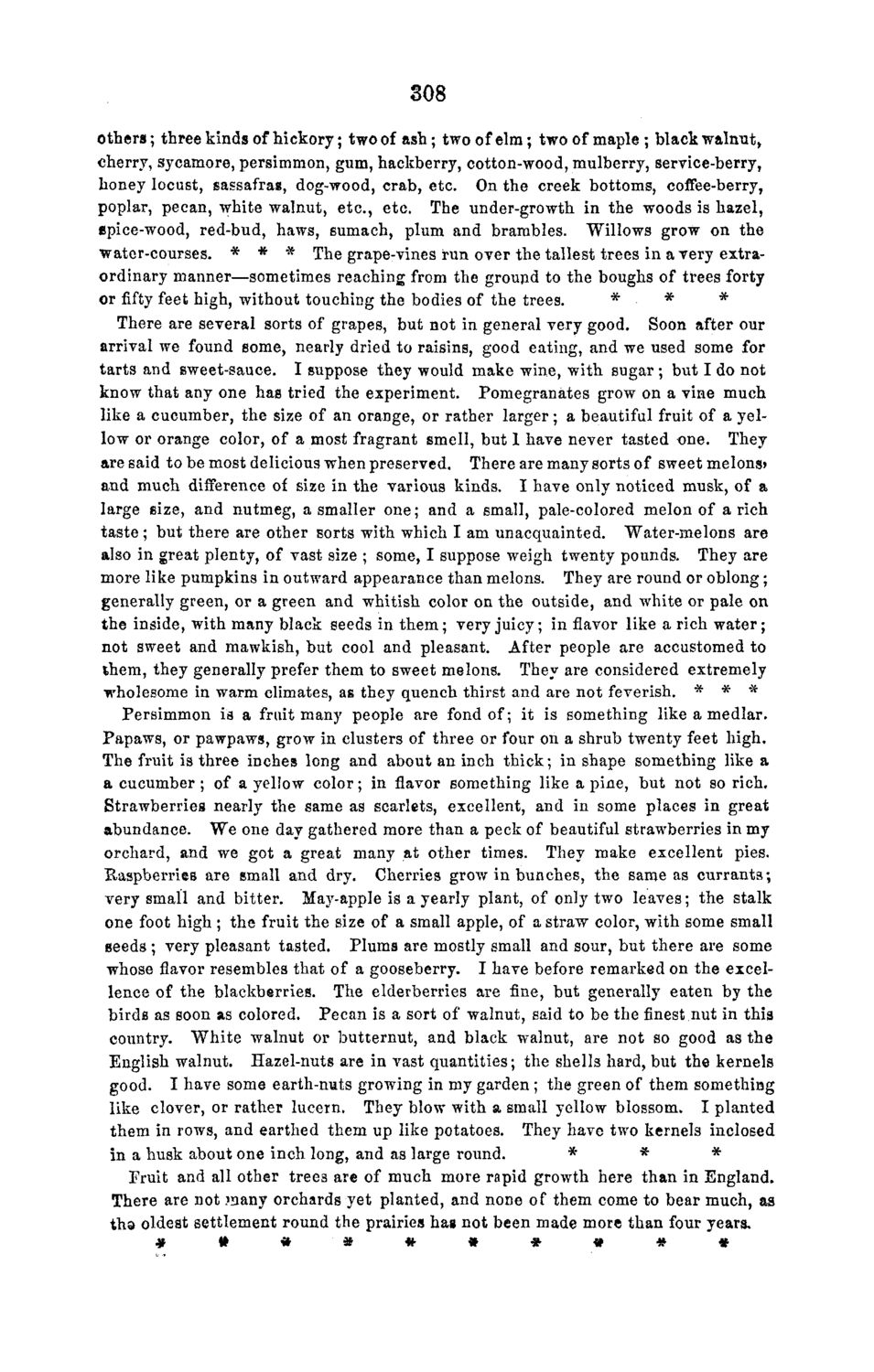| |
| |
Caption: Board of Trustees Minutes - 1868
This is a reduced-resolution page image for fast online browsing.

EXTRACTED TEXT FROM PAGE:
308 others; three kinds of hickory; two of ash; two of elm; two of maple ; black walnut, cherry, sycamore, persimmon, gum, hackberry, cotton-wood, mulberry, service-berry, honey locust, sassafras, dog-wood, crab, etc. On the creek bottoms, coffee-berry, poplar, pecan, white walnut, etc., etc. The under-growth in the woods is hazel, epice-wood, red-bud, haws, sumach, plum and brambles. Willows grow on the water-courses. * * * The grape-vines run over the tallest trees in a very extraordinary manner—sometimes reaching from the ground to the boughs of trees forty or fifty feet high, without touching the bodies of the trees. # . * * There are several sorts of grapes, but not in general very good. Soon after our arrival we found some, nearly dried to raisins, good eating, and we used some for tarts and sweet-sauce. I suppose they would make wine, with sugar; but I do not know that any one has tried the experiment. Pomegranates grow on a vine much like a cucumber, the size of an orange, or rather larger; a beautiful fruit of a yellow or orange color, of a most fragrant smell, but 1 have never tasted one. They are said to be most delicious when preserved. There are many sorts of sweet melons* and much difference of size in the various kinds. I have only noticed musk, of a large size, and nutmeg, a smaller one; and a small, pale-colored melon of a rich taste ; but there are other sorts with which I am unacquainted. Water-melons are also in great plenty, of vast size ; some, I suppose weigh twenty pounds. They are more like pumpkins in outward appearance than melons. They are round or oblong; generally green, or a green and whitish color on the outside, and white or pale on the inside, with many black seeds in them; very juicy; in flavor like a rich water; not sweet and mawkish, but cool and pleasant. After people are accustomed to them, they generally prefer them to sweet melons. They are considered extremely wholesome in warm climates, as they quench thirst and are not feverish. * * * Persimmon is a fruit many people are fond of; it is something like a medlar. Papaws, or pawpaws, grow in clusters of three or four on a shrub twenty feet high. The fruit is three inches long and about an inch thick; in shape something like a a cucumber; of a yellow color; in flavor something like a pine, but not so rich. Strawberries nearly the same as scarlets, excellent, and in some places in great abundance. We one day gathered more than a peck of beautiful strawberries in my orchard, and we got a great many at other times. They make excellent pies. Kaspberries are small and dry. Cherries grow in bunches, the same as currants; very small and bitter. May-apple is a yearly plant, of only two leaves; the stalk one foot high ; the fruit the size of a small apple, of a straw color, with some small seeds ; very pleasant tasted. Plums are mostly small and sour, but there are some whose flavor resembles that of a gooseberry. I have before remarked on the excellence of the blackberries. The elderberries are fine, but generally eaten by the birds as soon as colored. Pecan is a sort of walnut, said to be the finest nut in this country. White walnut or butternut, and black walnut, are not so good as the English walnut. Hazel-nuts are in vast quantities; the shells hard, but the kernels good. I have some earth-nuts growing in my garden; the green of them something like clover, or rather lucern. They blow with a small yellow blossom. I planted them in rows, and earthed them up like potatoes. They have two kernels inclosed in a husk about one inch long, and as large round. * * * Fruit and all other trees are of much more rapid growth here than in England. There are not .many orchards yet planted, and none of them come to bear much, as tha oldest settlement round the prairies has not been made more than four years.
| |